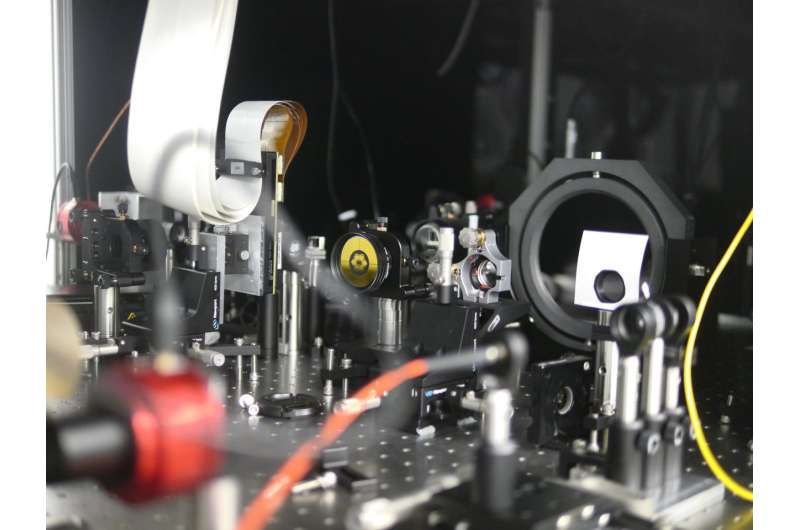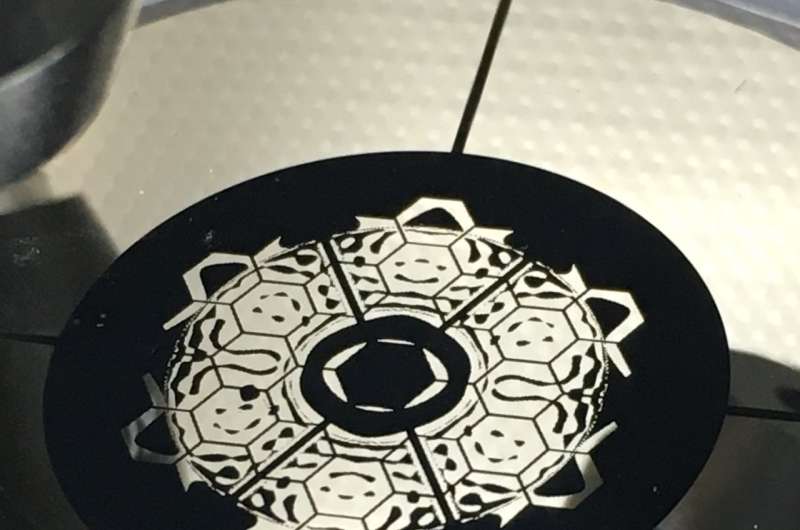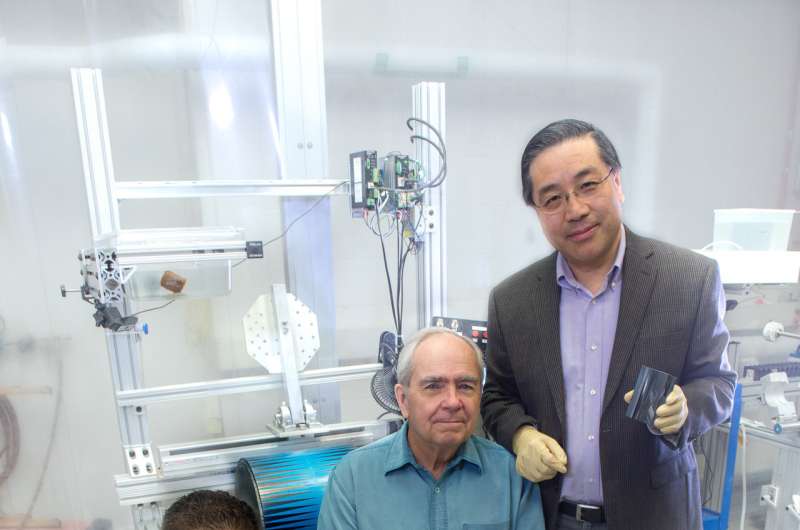NASA teams study the agency's future in astrophysics; tackle formidable technology challenges

What does NASA's future look like? Will the next-generation telescope investigate the first black holes in the distant universe or will it look for life on an Earth-like planet light-years away? As in past decades, the agency won't make that decision in a vacuum or without understanding the technical obstacles, which are formidable.
Already, teams of experts from across the agency, academia, and industry are studying four potential flagship missions that the science community has vetted as worthy pursuits under the 2020 Decadal Survey for Astrophysics. In March, they submitted interim reports. Next year, they are expected to finish final reports that the National Research Council will then use to inform its recommendations to NASA in a couple years.
"This is game time for astrophysics," said Susan Neff, chief scientist of NASA's Cosmic Origins Program. "We want to build all these concepts, but we don't have the budget to do all four at the same time. The point of these decadal studies is to give members of the astrophysics community the best possible information as they decide which science to do first."
NASA's Goddard Space Flight Center in Greenbelt, Maryland, leads two: the Large Ultraviolet/Optical/Infrared Surveyor (LUVOIR) and the Origins Space Telescope (OST). NASA's Jet Propulsion Laboratory (JPL) in Pasadena, California, and the Marshall Space Flight Center in Huntsville, Alabama, meanwhile, are respectively leading the Habitable Exoplanet Imager (HabEx) and the X-ray Surveyor, known as Lynx (see details of each).
Regardless of which mission NASA ultimately selects or the technologies it flies, the agency and individual centers have begun investing in advanced tools needed to pursue these bold, breakthrough concepts in the future, said Thai Pham, the technology development manager for NASA's Astrophysics Program Office. "I'm not saying it will be easy. It won't be," he continued. "These are ambitious missions, with significant technical challenges, many of which overlap and apply to all. The good news is that the groundwork is being laid now."
Unprecedented Picometer-Level Stability
LUVOIR provides a case in point.
One concept of the observatory envisions a supersized, segmented primary mirror about 49 feet in diameter. With this behemoth, LUVOIR could help answer how life began, what conditions are vital for the formation of stars and galaxies, and perhaps most compellingly, is Earth rare in the cosmos?
"LUVOIR will search for signs of life, but it doesn't stop there. It will tell us how life got there and how rare life is in the cosmos," said Shawn Domagal-Goldman, deputy study scientist. "This mission is ambitious," agreed Study Scientist Aki Roberge, "but finding out if there is life outside the solar system is the prize. All the technology tall poles are driven by this goal."
To directly image Earth-sized planets and assess their atmospheres, LUVOIR would have to acquire light from a relatively tiny object at least 10 billion times fainter than the star it encircles. This would be like discerning an object no wider than a human hair from a distance of two football fields, Roberge said.
To do this, LUVOIR's optics and associated hardware must be ultra-stable; that is, these components can't move or distort more than 12 picometers—a measurement smaller than the size of a hydrogen atom. Not only would the observatory have to maintain these exacting standards while making a measurement, so would its mirror segments.
Like the 21-foot primary mirror on the James Webb Space Telescope, LUVOIR's mirror would be made up of adjustable segments that would unfold after launch. Because capturing light from a faint and distant source would require a precisely focused wavefront, actuators or motors attached to the back of each mirror then would actively adjust and align the segments to achieve a perfect focus.
"Physical stability, plus active control on the primary mirror and an internal coronagraph (a device for blocking starlight) will result in picometer accuracy," Roberge said. "It's all about control."

Already a Goddard team has begun developing laboratory tools that can dynamically detect picometer-sized distortions that occur when materials used to build telescopes shrink or expand due to wildly fluctuating temperatures or when exposed to fierce launch forces. Should NASA select LUVOIR as its next flagship mission, NASA could use this tool to assure that the agency builds an observatory to these benchmarks.
Suppressing Starlight: A Shared Technical Challenge
HabEx, though physically smaller than LUVOIR, would also directly image planetary systems and analyze the composition of the planets' atmospheres with its large segmented mirror. In addition, it will enable a broad range of general astrophysics, from studying the earliest epochs of the history of the universe, to understanding the life cycle and deaths of the most massive stars, which ultimately supply the elements that are needed to support life as we know it.
Like LUVOIR, it, too, must fly a large, stable telescope sensitive to ultraviolet, optical, and near-infrared photons as well as technologies to block the parent star's bright light and create a dark zone revealing the presence of an Earth-sized planet.
"To directly image a planet orbiting a nearby star, we must overcome a tremendous barrier in dynamic range: the overwhelming brightness of the star against the dim reflection of starlight off the planet, with only a tiny angle separating the two," said Neil Zimmerman, a NASA expert in the field of coronagraphy. "There is no off-the-shelf solution to this problem because it is so unlike any other challenge in observational astronomy."
To overcome the challenge—likened to trying to photograph a firefly circling a streetlight from thousands of miles away—researchers are studying different approaches for suppressing starlight, including external petal-shaped star shades that block light before it enters the telescope and internal coronagraphs that employ masks and other components to prevent starlight from reaching the detectors. The HabEx team is investigating both techniques.
But a big hurdle remains: even with multiple coronagraphic masks, starlight will still get through, said Rémi Soummer, a scientist at the Space Telescope Science Institute in Baltimore, Maryland. Starlight will diffract off the edges of a coronagraph's optical components, making it difficult to completely block the light to see a small planet orbiting the star. One possible solution is to apply carbon nanotubes onto the coronagraphic masks that modify the pattern of diffracted light.
Soummer, who created a state-of-the-art testbed for evaluating different coronagraphic approaches primarily for LUVOIR, is collaborating with former Goddard optical engineer John Hagopian to test the effectiveness of Hagopian's carbon-nanotube technology for this application. This super-black coating consists of multi-walled nanotubes 10,000 times thinner than a strand of human hair. "When light penetrates the nanotube forest with minimal reflection, the light's electric field excites the electrons, turning light to heat and effectively absorbing it," explained Hagopian, now a Goddard contractor.
Test results so far are promising, Soummer said. But the verdict is still out. While Hagopian works to improve his technology's ability to absorb nearly all light, Soummer plans to test coronagraph masks using another light-suppression technology called silicon grass. Developed by JPL researchers, silicon grass consists of a forest of tiny needles etched into the surface of a thin silicon wafer. "My job is to compare the performance of the different techniques," Soummer said.
"Detectors, Detectors, Detectors"
Although large arrays of detectors measuring in the millions of pixels are a must for LUVOIR, HabEx, and Lynx, they are particularly important for OST, a far-infrared observatory designed to observe the farthest reaches of the universe.
"When people ask about technology gaps in developing the Origins Space Telescope, I tell them the top three challenges are detectors, detectors, detectors," said Dave Leisawitz, a Goddard scientist and OST study scientist. "It's all about the detectors."
NASA researchers are currently advancing different types of superconducting detectors for next-generation telescopes, but OST could benefit more from either of two emerging types: Transition Edge Sensors (TESs) or Kinetic Inductance Detectors (KIDs). TES detectors have reached a high degree of technological maturity and are now used in HAWC+, an instrument on NASA's Stratospheric Observatory for Infrared Astronomy, commonly known as SOFIA. "While relatively early in its technology readiness, KIDs are quickly maturing, and may find uses in future astronomical instruments," said Johannes Staguhn, a detector expert at Goddard and deputy study scientist and instrument scientist for OST.

However, neither detector technology can fulfill its promise unless the observatory is actively cooled to a frosty 4 kelvin, or -452.47 degrees Fahrenheit. That's because the light it's collecting—light that first began its journey across the universe literally billions of years ago—reaches space telescopes as heat. If the observatory and its instruments generate too much heat, it will overwhelm the signal the telescope wants to collect and measure.
As a result, OST's segmented primary mirror—now projected to span nearly 30 feet in diameter—would have to be cooled to about 4 K. If NASA chooses OST, the observatory would be NASA's first actively cooled telescope. According to Leisawitz, the OST team would like to achieve this by flying layers of sunshields that would envelope the mirror and radiate heat away from it. Four cryocoolers or heat sinks would then mechanically absorb the residual heat to maintain the mirror's 4 K target temperature.
OST's instrument detectors must be cooled as well—to 0.05 K, or one twentieth of a degree above absolute zero. This is 80 times colder than the observatory itself. The study team believes it can accomplish this technical feat with a multi-stage continuous adiabatic demagnetization refrigerator (CADR).
The technology, developed by Goddard cryogenic engineers, has flown on past X-ray missions. It cools to this very low temperature by varying the magnetic fields inside rods of specialized materials and ultimately conducting heat away to a 4 kelvin cryocooler. "The CADR has no moving parts, produces no vibrations, and works independent of gravity, making it very suitable for space missions," said Goddard cryogenic engineer Jim Tuttle.
Mirrors and Cool Detectors to Reveal the Hidden Universe
Cooling technologies and higher-performing detectors also present challenges for Lynx. Named after the sharp-sighted feline, the proposed observatory is the only of the four to examine the universe in X-rays. One of its principal jobs would be to detect this more energetic form of light coming from supermassive black holes at the center of the very first galaxies.
"Supermassive black holes have been observed to exist much earlier in the universe than our current theories predict," said Rob Petre, a Lynx study member at Goddard. "We don't understand how such massive objects formed so soon after the time when the first stars could have formed. We need an X-ray telescope to see the very first supermassive black holes, in order to provide the input for theories about how they might have formed."
To unravel the mystery, the Lynx study team is considering flying an X-ray microcalorimeter imaging spectrometer, among other instruments. With microcalorimetry, X-ray photons strike the detector's absorbers and their energy is converted to heat, which a thermometer then measures. The heat is directly proportional to the X-ray's energy, which can reveal much about the target's physical properties. Because microcalorimeters essentially are thermometers, they must be cooled to cryogenic temperatures to detect these fleeting, hard-to-capture X-rays.
NASA has made strides in these areas, Petre said. A Goddard team provided the cooling technology, a two-stage ADR, and a 36-pixel microcalorimeter array for the Japanese Suzaku and Astro-H missions. For Lynx, however, these technologies must become larger and more capable.
Currently, Goddard scientists Simon Bandler and Caroline Kilbourne are scaling up the size of the microcalorimeter array and, in fact, are developing a 4,000-pixel microcalorimeter array for the European Space Agency's Advanced Telescope for High-Energy Astrophysics, or Athena, mission. Athena is expected to launch in the late 2020s. Their goal is to ultimately create an array containing 100,000 pixels. Meanwhile, Goddard cryogenic experts, led by Tuttle, are adding stages to the refrigerator. The same multi-stage cooling system baselined for Lynx also could be used on OST, Tuttle said.
Lynx also would require a lightweight optic offering a significantly larger collection area and dramatically improved resolution. Unlike other mirrors that collect less energetic light, X-ray optics must be curved and nested inside a canister so that incoming photons graze the mirrors' surface and deflect into the observatory's instruments. The greater the number of mirrors, the higher the resolution.
One possible approach is using a relatively inexpensive, easily reproducible optic made of single-crystal silicon, a hard, brittle, non-metallic element used to make computer chips. Now being developed by NASA optics expert Will Zhang, the material has proven effective at gathering X-rays, Petre said. Because these mirrors are thin and lightweight, Lynx could carry thousands of individual mirror segments to improve its light-gathering power.
Although two other competing technologies exist, Zhang is confident Lynx would profit from his work. "The quality of the mirrors we are making today is several times better than a year ago. We are meeting or close to meeting Lynx requirements, but a year or so from now, we definitely will be meeting them."
Provided by NASA's Goddard Space Flight Center





















